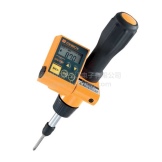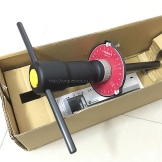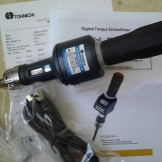All About Torque Screwdrivers

The automotive and construction industries use a special tool called a torque screwdriver to tighten bolts. This device allows you to maintain a certain tightening torque with maximum accuracy. There are several types of screwdrivers with a dynamometer, each of which differs in technical characteristics and design features.



What it is?
The torque screwdriver is a modern tool that is equipped with a built-in torque gauge. Such a device is indispensable when performing high-quality tightening of threaded connections. Most often, the device is used during the installation of building structures, industrial equipment and in the field of car service. The main advantage of such screwdrivers is that they completely eliminate breakdowns and problems with the operation of the tightening elements. The tool has the ability to set the required speed, protecting the equipment from damage when tightened.
The device of a torque screwdriver can be different, it is determined by the functionality and scope of the tool. The standard design consists of a robust housing with a spring, a removable nozzle, an adjustment knob and a locking pin. In addition, the tool is supplemented with a measuring scale, with which you can control the actuation forces. Such devices are compact and are very popular both in professional workshops and in everyday life.




Views
Today the construction market is represented by a wide range of tools, which provide a mechanism for measuring the tightening force. At the same time, an electronic screwdriver with a dynamometer is in special demand among specialists. It is adjustable, therefore, it provides high-quality tightening of fasteners without the risk of breaking and damaging the mechanism.
Such screwdrivers are divided into three main types:
- torsion;
- limit;
- indicator.
Torsion screwdrivers are activated by bending a fixed arrow with a handle on which a special scale is located. Their measuring range is from 0 to 20 kg. m, drive size 1/2 inch. The error of such devices does not exceed 20%. The screwdrivers are easy to use as they can work in two directions. The advantages of the tool include an affordable cost, the disadvantages are the exclusion of the possibility of using in hard-to-reach places and low accuracy in measuring the moment. These devices are recommended for fixing fasteners that do not require high precision.
The limiting type screwdrivers are characterized by preliminary adjustment of the trigger torque. They are equipped with a special lock, scale and ratchet mechanism. This tool can control tightening forces from 0.5 to 150 kg. The units are available in a variety of drive sizes: 1, 3/4, 1/2, 3/8 and 1/4 inches. Screwdrivers function in two directions, their error rarely exceeds 8%.



The principle of operation of this device is simple: when the indicator of the set torque is reached, a click is heard in the handle. Thanks to this ratcheting mechanism, working with screwdrivers is simplified, the master only needs to adjust the torque and tighten the fasteners.
Limit screwdrivers manage to tighten a lot of bolts in a minimum amount of time.The advantage of the tool is that you can work with it in hard-to-reach places without monitoring the indicators of the arrows.
As for the indicator type, it has a triple function. The ratchet mechanism is responsible for locking, twisting and unscrewing. The design of the screwdriver is provided with a panel with a button for turning on and measuring torque, an LED indicator, a buzzer and a button for recalling the last operations from memory. In addition, the multifunction display allows you to edit and set parameters. At the push of a button, the instrument returns to standard operating mode.
Thanks to indicator screwdrivers with built-in dynamometer, it is possible to monitor the behavior of the fasteners. Manufacturers also complement the design with a scale on which one or two arrows (setting and signaling) can be placed. One of the arrows is usually set when choosing the value of the tightening torque, and the second - to fix the current indicator. The fasteners are tightened when both arrows are aligned. This device is designed for double-sided operation and is used when tightening elements with both left and right threads.




The main advantage of indicator devices is that their error is up to 1%. In addition, the tool is easy to customize for any unit of measurement: kg / cm, kg / m, Nm / cm, Nm / m, ft / lb. Screwdrivers of this type can compensate for temperatures and keep the data of the last operations in memory. Upon reaching the tightening torque, the device emits sound and light indication. The disadvantage of the device is its high cost.
To expand the capabilities of torque screwdrivers, they are additionally equipped with special bits, which allow you to work in hard-to-reach places where the head cannot reach the fasteners. The most commonly used nozzles are ratchet, horn and cap type. They differ in landing area and profile size. Thanks to such devices, a tool with a dynamometer becomes universal. Therefore, each master is recommended to have a complete set of interchangeable nozzles in a complete set with screwdrivers.


How to choose?
The torque screwdriver is considered a popular tool and is second to none in the controlled tightening of fasteners. In order for this tool to serve for a long time and allow you to perform work with high quality, when choosing it, you should pay attention to a number of parameters.
- Manufacturing material. It is best to give preference to products in which the rod is made of durable steel and coated with chrome plating. Such a device is durable and is not afraid of corrosion, the negative effects of abrasive materials and oil.
- Torque range. Since dynamometers are produced with a torque of 0.04 to 1000 Nm, it must be taken into account that they are manually operated with a low value. In addition, you should know what kind of effort you plan to use most often, and calculate its average level. So, with constant tightening of fasteners with a force of 50 Nm, you can purchase a screwdriver with a range from 20 to 100 Nm. With forces above 100 kg / m, it will be difficult to tune the tool manually, so it is recommended to buy attachments equipped with multipliers. This will facilitate the work of the master and will allow you to control the accuracy of the tightening.
- The ratio of the drive key to the dimensions of the multiplier surface. Screwdrivers must be selected in such a way that their indicators coincide in size with the input multiplier. For example, with a force of 8000 Nm and a gear ratio of 1: 23.1, you need to divide 8000 by 23.1, resulting in a value of 347 Nm. This means that you need a screwdriver with a force of 60 to 340 Nm to work.




In the following video, see an overview of the WERA and WIHA torque screwdrivers for electrical installation.













The comment was sent successfully.